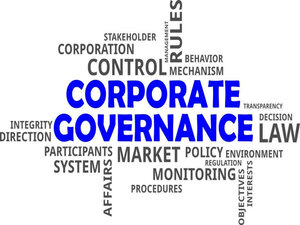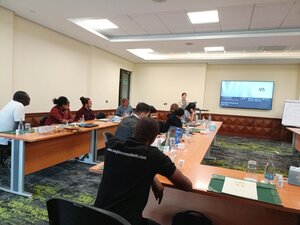Course Overview
The Board’s role in the company’s strategic management, the selection process for and evaluation of the CEO’s performance, the succession planning process and guidelines for key positions, and providing directors with the resources they need to exercise reasonable and knowledgeable oversight over the company’s financial performance.
This curriculum covers the fundamentals of corporate governance, best practices, and useful tools for promoting good governance. It serves as the program’s cornerstone and provides an introduction to the function of the board of directors and the significance of sound corporate governance.
Course outline
Companies that practice good corporate governance are more likely to perform better, have easier access to capital, and have long-term growth. The program will concentrate on the distinct corporate governance issues that organizations experience and present frameworks and procedures that can lessen these issues and guarantee the survival of the company. It goes beyond fundamental theories and offers clear, useful solutions for implementing crucial company governance dimensions.
The fundamentals of corporate governance will be covered, along with the board’s responsibilities for information disclosure and openness, enterprise risk management (ERM), the function and significance of internal and external audit, and how to set up effective control mechanisms.
Additionally, you’ll instruct them on the board’s duties and go through the fundamentals of corporate governance.



Course Objectives
- Obtain certification as a board member
- Develop a strong commitment to good governance and show that you are clearly focused on the structures and procedures that will enable you to reap the benefits of corporate governance.
- Learn about a board’s composition and operations to establish a capable and efficient board.
- To achieve internal control, risk management, and the integrity of financial information, increase management control.
- Learn about disclosure and transparency standards to deliver accurate and useful information to stakeholders and shareholders alike (including regulators)
- Adopt shareholder practices that ensure that all shareholders are treated fairly and are shielded from insider abuse
Organisational Benefits
- Gain from educating your staff about the definition and significance of board effectiveness in businesses, especially if it has any bearing on the main goals, values, mission, and vision of your company.
- Concentrate and target your efforts on the protocol and practices of the Board of Directors.
- By ensuring a connection between the board and operational employees, the business may strengthen its synergy, which will raise employee morale and boost productivity.
- Critically evaluate your organizational capabilities in terms of conformity with the aforementioned principles by conducting a gap analysis and performance audit.
Personal Benefits
- Enhance your performance through increased productivity and enhanced communication with your operational personnel by becoming aware of the effects and long-term benefits of adhering to board norms and procedures.
- Understanding the Board Practice Principles
- Participate in productive discussions about the subject to enhance organizational capability and communication in general.
- Put your knowledge about the effects of board effectiveness in your organization’s context and integrate it.
- Demonstrate knowledge of and comprehension of the key tenets governing the execution of board effectiveness. Training
- Recognize the many individuals, institutions, and organizations that interact with the Board of Directors in an organization, as well as their roles, functions, and responsibilities.
- Determine and assess the primary flaws that contribute to your organization’s board’s inefficiency.
Governance and Board Development Training Highlights
Training Feedback
Happy Customers
Course Outline
The justification for best practices in corporate governance
- Corporate governance definition, idea, and guiding principles
- The structure of corporate governance
- Important elements of corporate governance
- Good governance’s advantages and investors’ perspectives
The effective board: its role, powers, obligations, and liabilities
- Recognize that the Board and senior management have separate responsibilities.
- Recognize the functions of executive and non-executive directors.
- Compare the advantages and disadvantages of executive and non-executive chairs.
The makeup, structure, and requirement for independent directors on the board
- Board’s general structure
- Organization of Board committees
- Organizing the CEO / Chairman’s duties
- the selection of the ideal number of directors
- Choosing the appropriate skill mixture
- Independent and Non-Executive Directors’ Role: The Higgs Report
- Determine the appropriate committees for the Board and understand that the Chairman and CEO have distinct tasks dependent on the types of Boards they serve.
- Establish the ideal number of directors, talent mix, and proportion of independent, non-executive, and executive members.
Evaluation and compensation for executives and non-executives
- How to entice, keep, and inspire top executives and directors
- How to measure and evaluate the Board’s performance Executive compensation and performance-based pay
- How to determine board compensation
- Appreciate the significance of the Board’s performance review
- Recognize the executive compensation models used for directors and properly implement them in your organization.
The corporate secretary’s responsibilities, the board’s and its committees’ operating procedures
- Getting ready for Board meetings
- Quorum conditions
- working methods
- Corporate secretaries’ voting responsibilities
- qualifications needed
- Realize the advantages of the Board adhering to a set of working principles.
- Recognize that the Board’s agenda may be essential for regulating how the Board operates.
The board’s responsibility for formulating the company’s strategy
- many approaches to strategy
- Position of the Board in Strategic Management
- Corporate Strategy: Job Descriptions
- Dynamic Board/Management
- The procedure for making strategic decisions
- Corporate governance and strategic planning
- Participate in the strategy development of your organization.
- Analyze the role your board played in creating the business’s strategy.
- Recognize the best techniques for establishing a strategy in emerging markets.
- Recognize the Dynamics between the Board and Management: Barriers to Successful Strategy Development
A succession planning guide
- The idea of succession planning and its necessity
- How is the planning for important positions structured?
- Board’s responsibility for succession planning
- a succession planning framework
- Specifying the parties to whom the succession planning process should grant access
- planning for succession pitfalls
- Utilize best practices since they can be found at other businesses.
What each director should be aware of in terms of accounting and finance
- Accounting ideas and how they impact how accounting information is understood
- a brief summary of the company’s performance and financial condition
- IFRS-compliant disclosures
- Recognize the different kinds of financial statements.
- Gain knowledge of the important financial areas that require attention.
- know what financial questions to ask
- Exercise prudent and knowledgeable control over financial performance
Who Should Attend
- Senior marketing directors or managers
- Relationship managers and
- Customer relationship managers
- Professionals in customer service, supervisors,
- Team leaders, and managers
- Sales experts, salespeople, and sales analysts
- Entrepreneurs and founders of startups
Trainers Available for:
- In-House Trainings
- Online Training
- 2 Hours Crush Program
- Half Day Program
- One Day Program
- Two Days Full Program
Training Techniques
- Power point Presentations
- Engaging conversations
- Case studies
- Exercises in solving problems
- Focus Group Conversations
- Games in Management
- Skits and modeling the part
Request a Quote

